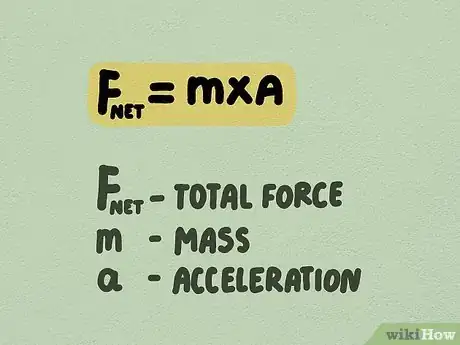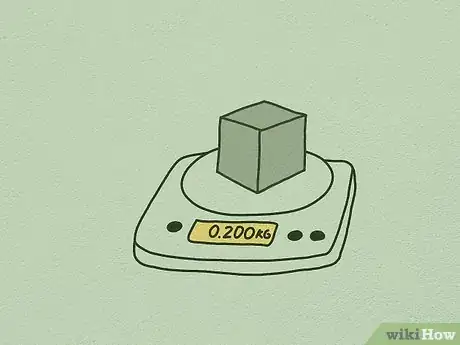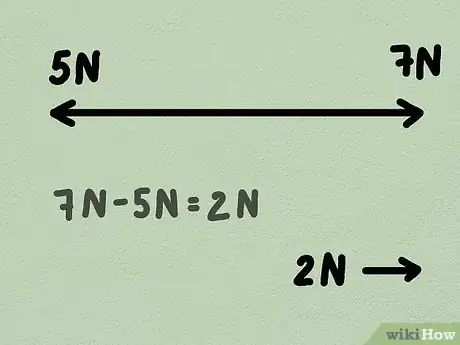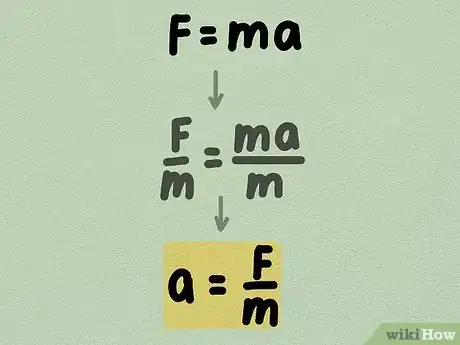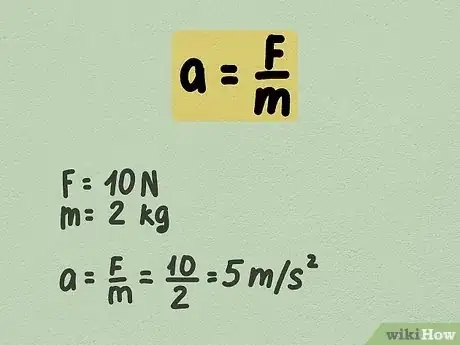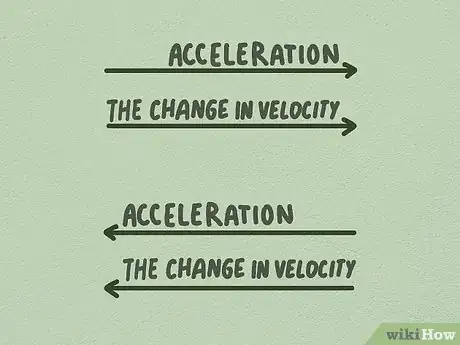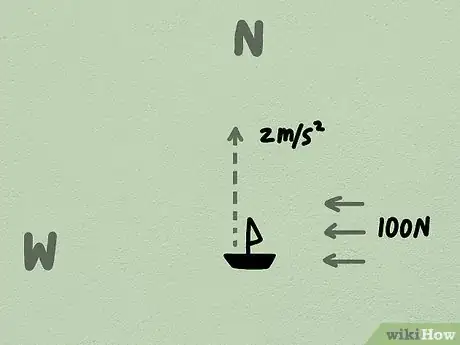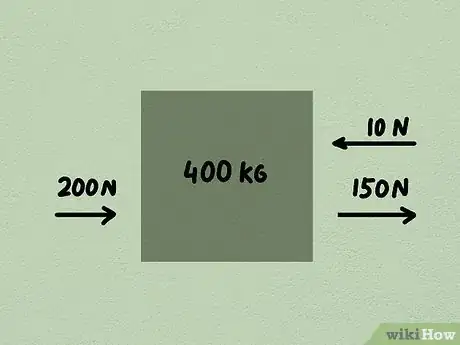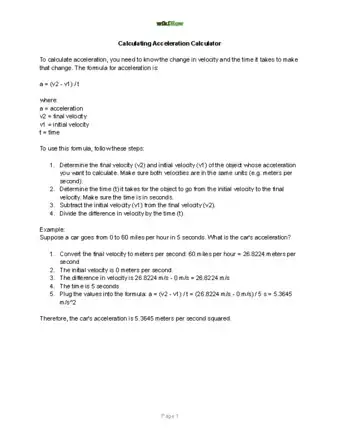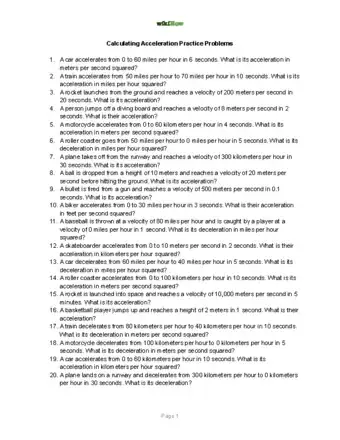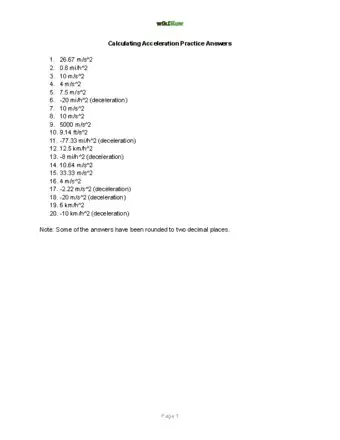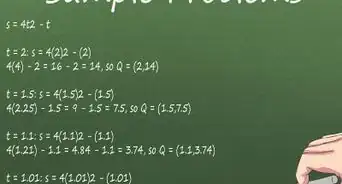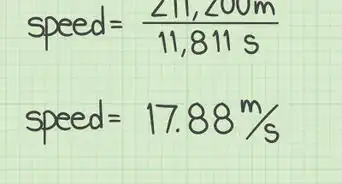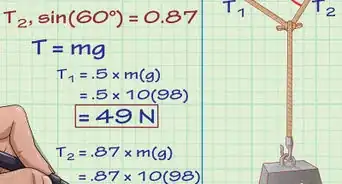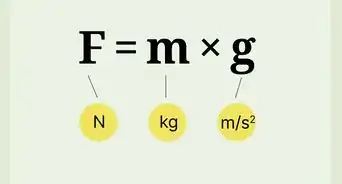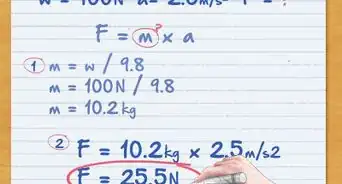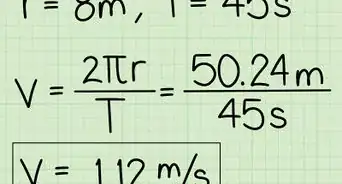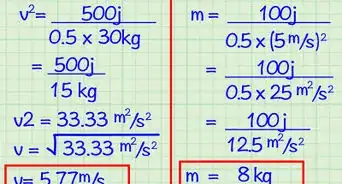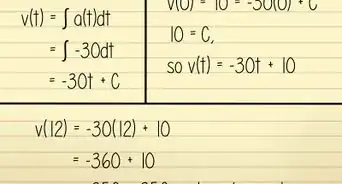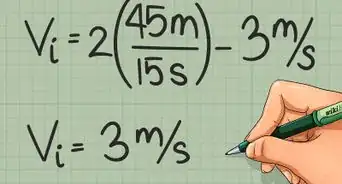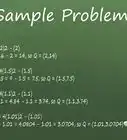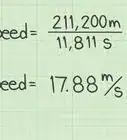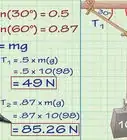This article was co-authored by Sean Alexander, MS. Sean Alexander is an Academic Tutor specializing in teaching mathematics and physics. Sean is the Owner of Alexander Tutoring, an academic tutoring business that provides personalized studying sessions focused on mathematics and physics. With over 15 years of experience, Sean has worked as a physics and math instructor and tutor for Stanford University, San Francisco State University, and Stanbridge Academy. He holds a BS in Physics from the University of California, Santa Barbara and an MS in Theoretical Physics from San Francisco State University.
There are 9 references cited in this article, which can be found at the bottom of the page.
This article has been viewed 1,746,872 times.
If you’ve ever watched a bright red Ferrari fly ahead of your Honda Civic after a stoplight, you’ve experienced differing rates of acceleration firsthand. Acceleration is the rate of change in the velocity of an object as it moves. You can calculate this rate of acceleration, measured in meters per second, based on the time it takes you to go from one velocity to another, or based on the mass of an object.[1]
Steps
Calculating Acceleration from a Force
-
1Define Newton’s Second Law of Motion. Newton’s second law of motion states that when the forces acting on an object are unbalanced, the object will accelerate. This acceleration is dependent upon the net forces that act upon the object and the object’s mass.[2] Using this law, acceleration can be calculated when a known force is acting on an object of known mass.
- Newton’s law can be represented by the equation Fnet = m x a, where Fnet is the total force acting on the object, m is the object’s mass, and a is the acceleration of the object.
- When using this equation, keep your units in the metric system. Use kilograms (kg) for mass, newtons (N) for force, and meters per second squared (m/s2) for acceleration.
-
2Find the mass of your object. To find the mass of an object, simply place it on a balance or scale and find its mass in grams. If you have a very large object, you may need to find a reference that can provide you with the mass.[3] Larger objects will likely have a mass with the unit of kilograms (kg).
- For this equation, you will want to convert the mass into kilograms. If the mass you have is in grams simply divide that mass by 1000 to convert to kilograms.
Advertisement -
3Calculate the net force acting on your object. A net force is an unbalanced force. If you have two forces opposing each other and one is larger than the other, you will have a net force in the direction of the larger force.[4] Acceleration happens when an unbalanced force acts on an object, causing it to change speeds towards the direction the force is pushing or pulling it.
- For example: Let’s say you and your big brother are playing tug-of-war. You pull the rope to the left with a force of 5 newtons while your brother pulls the rope in the opposite direction with a force of 7 newtons. The net force on the rope is 2 newtons to the right, in the direction of your brother.
- In order to properly understand the units, know that 1 newton (N) is equal to 1 kilogram X meter/second squared (kg X m/s2).[5]
-
4Rearrange the equation F = ma to solve for acceleration. You can change this formula around to solve for acceleration by dividing both sides by the mass, so: a = F/m.[6] To find the acceleration, simply divide the force by the mass of the object being accelerated.
- Force is directly proportional to the acceleration, meaning that a greater force will lead to a greater acceleration.
- Mass is inversely proportional to acceleration, meaning that with a greater mass, the acceleration will decrease.
-
5Use the formula to solve for acceleration. Acceleration is equal to the net force acting on an object divided by the mass of the object. Once you’ve established the values for your variables, do the simple division to find the acceleration of the object.
- For example: A 10 Newton force acts uniformly on a mass of 2 kilograms. What is the object’s acceleration?
- a = F/m = 10/2 = 5 m/s2
Calculating Average Acceleration from Two Velocities
-
1Define the equation for average acceleration. You can calculate the average acceleration of an object over a period of time based on its velocity (its speed traveling in a specific direction), before and after that time. To do this you need to know equation for acceleration: a = Δv / Δt where a is acceleration, Δv is the change in velocity, and Δt is the amount of time it took for that change to occur.[7]
- The unit for acceleration is meters per second per second or m/s2.[8]
- Acceleration is a vector quantity, meaning it has both a magnitude and a direction.[9] The magnitude is the total amount of acceleration whereas the direction is the way in which the object is moving. If it is slowing down the acceleration will be negative.
-
2Understand the variables. You can further define Δv and Δt: Δv = vf - vi and Δt = tf - ti where vf is the final velocity, vi is the initial velocity, tf is the ending time, and ti is the starting time.[10]
- Because acceleration has a direction, it is important to always subtract the initial velocity from the final velocity. If you reverse them, the direction of your acceleration will be incorrect.
- Unless otherwise stated in the problem, the starting time is usually 0 seconds.
-
3Use the formula to find acceleration. First write down your equation and all of the given variables. The equation is a = Δv / Δt = (vf - vi)/(tf - ti). Subtract the initial velocity from the final velocity, then divide the result by the time interval. The final result is your average acceleration over that time.
- If the final velocity is less than the initial velocity, acceleration will turn out to be a negative quantity or the rate at which an object slows down.
- Example 1: A race car accelerates uniformly from 18.5 m/s to 46.1 m/s in 2.47 seconds. What is its average acceleration?
- Write the equation: a = Δv / Δt = (vf - vi)/(tf - ti)
- Define the variables: vf = 46.1 m/s, vi = 18.5 m/s, tf = 2.47 s, ti = 0 s.
- Solve: a = (46.1 – 18.5)/2.47 = 11.17 meters/second2.
- Example 2: A biker traveling at 22.4 m/s comes to halt in 2.55 s after applying brakes. Find his deceleration.
- Write the equation: a = Δv / Δt = (vf - vi)/(tf - ti)
- Define the variables: vf = 0 m/s, vi = 22.4 m/s, tf = 2.55 s, ti = 0 s.
- Solve: a = (0 – 22.4)/2.55 = -8.78 meters/second2.
Confirming Your Understanding
-
1Understand the Direction of Acceleration. The physics concept of acceleration doesn't always match how we would use the term in everyday life. Every acceleration has a direction, usually represented as positive if it's UP or RIGHT, and negative if DOWN or LEFT. See if your answer makes sense based on this breakdown:
Behavior of a Car How is Velocity Changing? Direction of Acceleration Driver moving right (+) hits gas pedal + → ++ (more positive)
positive
Driver moving right (+) hits brakes ++ → + (less positive)
negative
Driver moving left (-) hits gas pedal - → -- (more negative)
negative
Driver moving left (-) hits brakes -- → - (less negative)
positive
Driver moves at constant velocity remains the same
acceleration is zero
-
2Understand the Direction of Force. Remember, a force only causes acceleration in the direction of the force. Some problems may try to trick you with irrelevant values.
- Example Problem: A toy boat with mass 10kg is accelerating north at 2 m/s2. A wind blowing due west exerts a force of 100 Newtons on the boat. What is the boat's new northward acceleration?
- Solution: Because the force is perpendicular to the direction of motion, it does not have an effect on motion in that direction. The boat continues to accelerate north at 2 m/s2.
-
3Understand Net Force. If more than one force acts on an object, combine them into a net force before you calculate acceleration. For a problem in two dimensions, this looks something like this:
- Example Problem: April is pulling a 400 kg container right with a force of 150 newtons. Bob stand on the left of the container and pushes with a force of 200 newtons. A wind blowing left exerts a force of 10 newtons. What is the acceleration of the container?
- Solution: This problem uses tricky language to try and catch you. Draw a diagram and you'll see the forces are 150 newtons right, 200 newtons right, and 10 newtons left. If "right" is the positive direction, the net force is 150 + 200 - 10 = 340 newtons. Acceleration = F / m = 340 newtons / 400 kg = 0.85 m/s2.
Calculator, Practice Problems, and Answers
Expert Q&A
-
QuestionHow do you solve acceleration word problems?
 Sean Alexander, MSSean Alexander is an Academic Tutor specializing in teaching mathematics and physics. Sean is the Owner of Alexander Tutoring, an academic tutoring business that provides personalized studying sessions focused on mathematics and physics. With over 15 years of experience, Sean has worked as a physics and math instructor and tutor for Stanford University, San Francisco State University, and Stanbridge Academy. He holds a BS in Physics from the University of California, Santa Barbara and an MS in Theoretical Physics from San Francisco State University.
Sean Alexander, MSSean Alexander is an Academic Tutor specializing in teaching mathematics and physics. Sean is the Owner of Alexander Tutoring, an academic tutoring business that provides personalized studying sessions focused on mathematics and physics. With over 15 years of experience, Sean has worked as a physics and math instructor and tutor for Stanford University, San Francisco State University, and Stanbridge Academy. He holds a BS in Physics from the University of California, Santa Barbara and an MS in Theoretical Physics from San Francisco State University.
Academic Tutor
-
QuestionWhat is the SI unit for acceleration?
 wikiHow Staff EditorThis answer was written by one of our trained team of researchers who validated it for accuracy and comprehensiveness.
wikiHow Staff EditorThis answer was written by one of our trained team of researchers who validated it for accuracy and comprehensiveness.
Staff Answer wikiHow Staff EditorStaff AnswerSI units are standardized units that are used internationally in scientific writing. When describing acceleration, use the SI units meters per seconds squared (m/s^2).
wikiHow Staff EditorStaff AnswerSI units are standardized units that are used internationally in scientific writing. When describing acceleration, use the SI units meters per seconds squared (m/s^2). -
QuestionHow do you calculate acceleration without time?
 wikiHow Staff EditorThis answer was written by one of our trained team of researchers who validated it for accuracy and comprehensiveness.
wikiHow Staff EditorThis answer was written by one of our trained team of researchers who validated it for accuracy and comprehensiveness.
Staff Answer wikiHow Staff EditorStaff AnswerIf you know that acceleration is constant, you can solve for it without time if you have the initial and final velocity of the object as well as the amount of displacement. Use the formula v^2=u^2+2as where v is the final velocity, u is the initial velocity, a is acceleration, and s is displacement. Solve for a to find acceleration.
wikiHow Staff EditorStaff AnswerIf you know that acceleration is constant, you can solve for it without time if you have the initial and final velocity of the object as well as the amount of displacement. Use the formula v^2=u^2+2as where v is the final velocity, u is the initial velocity, a is acceleration, and s is displacement. Solve for a to find acceleration.
References
- ↑ Sean Alexander, MS. Academic Tutor. Expert Interview. 14 May 2020.
- ↑ https://www1.grc.nasa.gov/beginners-guide-to-aeronautics/newtons-laws-of-motion/
- ↑ https://www.livescience.com/46560-newton-second-law.html
- ↑ http://www.physicsclassroom.com/Class/newtlaws/u2l2d.cfm
- ↑ http://study.com/academy/lesson/what-is-a-newton-units-lesson-quiz.html
- ↑ https://byjus.com/physics/newtons-second-law-of-motion-and-momentum/
- ↑ http://physics.info/acceleration/
- ↑ Sean Alexander, MS. Academic Tutor. Expert Interview. 14 May 2020.
- ↑ http://www.physicsclassroom.com/Class/1DKin/U1L1e.cfm#vttable
About This Article
To calculate acceleration, use the equation a = Δv / Δt, where Δv is the change in velocity, and Δt is how long it took for that change to occur. To calculate Δv, use the equation Δv = vf - vi, where vf is final velocity and vi is initial velocity. To caltulate Δt, use the equation Δt = tf - ti, where tf is the ending time and ti is the starting time. Once you've calculated Δv and Δt, plug them into the equation a = Δv / Δt to get the acceleration. To learn how to calculate acceleration from a force, read the article!

